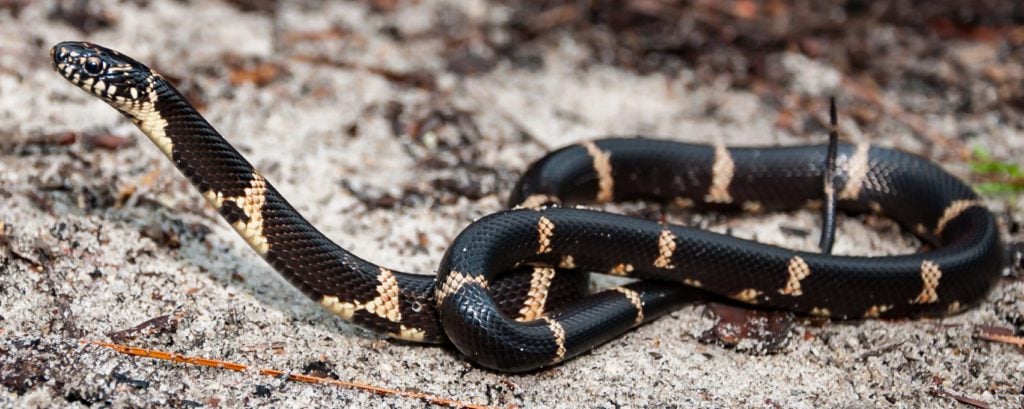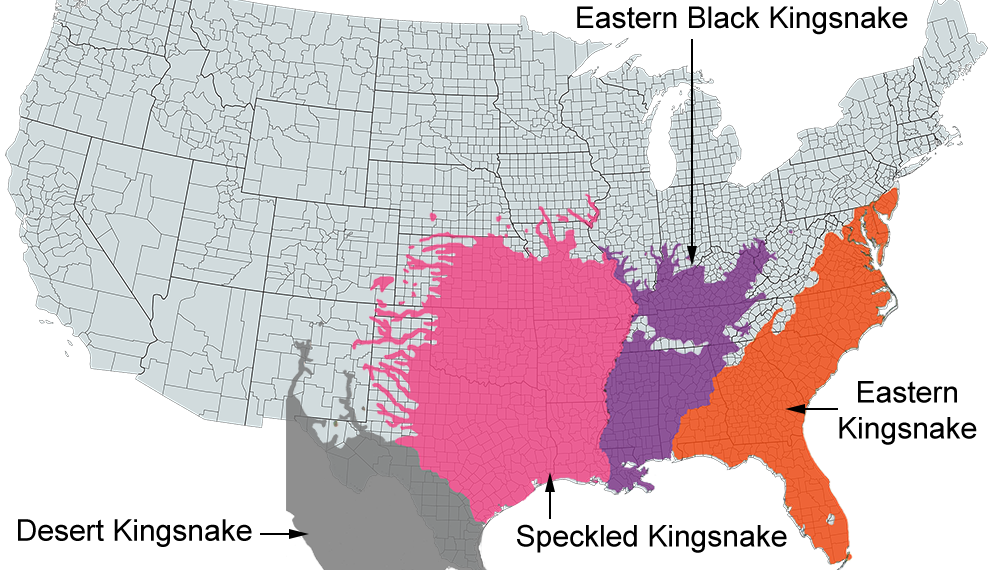4 Types of Kingsnakes & Milksnakes in Kentucky!
Finding kingsnakes and milksnakes in Kentucky can be difficult!

Here’s why:
Most members of the genus Lampropeltis (kingsnakes & milksnakes) spend a lot of their time hidden beneath objects or underground. So while it’s not unheard of, it’s not very common to just stroll past one while walking outside.
Regardless, these non-venomous, mostly docile snakes are fascinating. For example, did you know that kingsnakes EAT venomous snakes? Believe it or not, it’s true!
Today, you’re going to learn about the 4 types of kingsnakes and milksnakes in Kentucky!
-
RELATED: The 28 Types of SNAKES That Live in Kentucky! (ID Guide)
-
RELATED: The 9 Types of Lizards Found in Kentucky! (With Photos)
#1. Eastern Milksnake
- Lampropeltis triangulum triangulum

Identifying Characteristics:
- Adults typically range from 24 to 36 inches in length.
- Coloration is tan or gray with 3 to 5 rows of reddish-brown, black-edged blotches.
- Look for a gray or tan Y- or V-shaped mark near the rear of the head.
Eastern Milksnakes get their unique name from an old myth that they milked cows since they’re commonly found in barns! Obviously, this isn’t true. Their presence inside barns is likely due to the high number of mice, which are some of their favorite prey.
Eastern Milksnake Range Map

A member of the kingsnake family, Eastern Milksnakes occupy a wide variety of habitats in Kentucky, including fields, woodlands, agricultural areas, and rocky outcrops. These beautiful snakes are somewhat secretive and spend much of their time beneath the ground. You may be able to find one underneath rocks, logs, boards, and other debris.
The Eastern Milksnake prefers to feed on small mammals such as mice and shrews. However, they’ll also consume various types of prey, including birds and bird eggs, lizards, snakes, amphibians, fish, earthworms, slugs, insects, and carrion.

Like other individuals in the kingsnake family, they will prey on venomous pit vipers. So how do they combat the venom? Interestingly, their blood contains venom-neutralizing properties!
#2. Prairie Kingsnake
- Lampropeltis calligaster calligaster

Identifying Characteristics:
- Adults range from 30 to 40 inches in length.
- Coloration is typically gray or light brown with darker gray, brown, or reddish-brown blotching, sometimes outlined in black, down the length of their body which fades with age.
- They have a pale or yellowish underside, and their head is indistinct from their body.
- The Prairie Kingsnake is a subspecies of the Yellow-bellied Kingsnake.
Look for Prairie Kingsnakes in Kentucky in open habitats, such as fields, farmland, rocky hillsides, and open woodlands. They spend most of their time underground and are found under rocks, logs, and old animal burrows throughout their active period and for winter hibernation.
Prairie Kingsnake Range Map

These snakes feed on a wide variety of prey, such as mice, lizards, other snakes (including other Prairie Kingsnakes), insects, birds, bird eggs, and amphibians. They constrict their prey, coiling around and suffocating it before consuming.
If disturbed, the Prairie Kingsnake may try to warn perceived threats by mimicking a rattlesnake. They accomplish this mimicry by shaking the tip of their tail in dry leaf litter. However, these snakes are non-venomous and don’t typically bite, but they will release a foul-smelling musk if grabbed!
This species is considered of least concern and doesn’t seem to face any significant conservation risks. However, they are sometimes run over when crossing roads or killed because they are mistaken for being venomous. Like many other kingsnakes, this species is sometimes kept as pets.
#3. Eastern Black Kingsnake
- Lampropeltis nigra
Identifying Characteristics:
- Adults typically range from 35 to 48 inches in length.
- Coloration is black with wide, cream, or yellow speckles, larger and more numerous on the sides.
- Stocky body, head indistinct from the neck, and a yellow or cream underside with black checkering.
- Also frequently referred to as just “Black Kingsnake.”
Eastern Black Kingsnakes occupy various habitats in Kentucky.
They can be found in forests, agricultural lands, thick brush around streams and swamps, floodplain and wetland edges, and even suburban areas!
Eastern Black Kingsnake Range Map

These kingsnakes are very secretive, and they often seek shelter under logs and other debris. They’re primarily active during the daytime but are most active in the morning during the summer.
Being constrictors, they use their strong coils to asphyxiate their prey. Eastern Black Kingsnakes frequently prey on lizards, rodents, birds, turtle eggs, and other snakes, including venomous pit vipers.
Though they’re non-venomous, these kingsnakes may shake their tails if disturbed. In dry leaves, it sounds much like a rattlesnake! If handled, they may also release a foul-smelling musk and strike.
#4. Scarlet Kingsnake
- Lampropeltis elapsoides

Identifying Characteristics:
- Adults typically range from 14 to 20 inches in length.
- Coloration is alternating red, black, and yellow rings encircling the body; the yellow and red rings never touch.
- Small head, barely distinct from the neck and a red snout.
Scarlet Kingsnakes can be found in pine flat woods, pine-oak forests, fields, agricultural areas, and occasionally urban environments. But they are hard to see because they are secretive and mostly stay underground. Look for them under logs, rocks, boards, and other debris. However, they’re also excellent climbers and are sometimes spotted on trees and buildings.
Scarlet Kingsnake Range Map

These vividly colored non-venomous snakes are sometimes mistaken for venomous coral snakes. In fact, they were used as stand-ins for venomous snakes in the movies “Snakes on a Plane” and “The Mummy Returns.”
So how do you tell the difference between a dangerous coral snake and a harmless Scarlet Kingsnake in Kentucky?

Just remember this rhyme and you’ll never have to worry! “If red touches yellow, you’re a dead fellow; if red touches black, you’re all right, Jack.”
These kingsnakes are generally non-aggressive. However, they may vibrate their tail if disturbed, producing a buzzing sound when in leaf litter. If grabbed, they may strike and release a foul-smelling musk.
Do you need additional help identifying a snake?
Try this field guide!
Which of these kingsnakes and milksnakes have you seen before in Kentucky?
Leave a comment below!


